
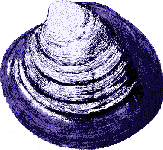
WAMPUM -- TREATIES, SACRED RECORDS
|
On the left, Atlantic whelks, the type of shell from which chains of white wampum tubular beads (which were strung in coimplex chains) were made -- from the long central spiral inside the shell. Right, a quahog, the Atlantic clam from which the more rectangular purple wampum beads were made. Its name comes from the Narraganset word po-qua-hock. Belt-wampum beads were rectangular cutouts, with drilled holes, rolled smooth on sandstone, then woven into a shell-beaded fabric. They recorded agreements, with the purple color predominant if the agreement was considered more important, serious, or sad. 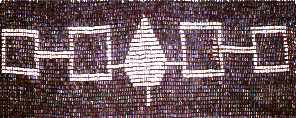 The Hiawatha BeltThis belt may be the oldest. It represents the first United Nations agreement, the first time in history anywhere on the globe where independent nations were able to join together under a unified government that allowed individual customs and governments of member nations. Prior to this idea, throughout the world's history in all places and times, national growth was by conquest and forced subjection -- empire growth. This belt memorialized Haudaunosee, League of the Pine Tree (center) or Great Peace, of the 5 original Iroquois Nations, who became the 6 Nations after they received fleeing southern Tuscarora into the League.
The original League was the 5 first Iroquoian Nations. Onandaga were (are) Firekeepers and wampum-keepers and are represented as in the center, "Under the Pine Tree" where meetings were held, at their town. Mohawks (Kanienkehake, People of the Flint) are represented as the Eastern Door; Seneca as the Western Door. Oneida and Cayuga are the two central squares. The Constitution of the Iroquois Nations -- archived in World History archives -- is a detailed recording which was memorized, recited regularly, and recorded on wampum belts. There are several different translations or interpretations of this constitution. A small book of one which was worked out with elders of the 6 Nations (Tusacarora refugees joined the League at the end of the 18th century) was published in English by Akwesasne Notes in 1972. Wampum Belts of Treaties, Agreements with Invaders
|
|---|

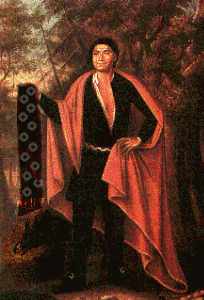 |
In 1710, British colonial authorities sent 4 sachems of the League -- 3 Mohawks and a Mahican -- to London for diplomatic palavers, to enlist them against the French. Queen Anne had their portraits painted. Wolf Clan Mohawk Tiyeeneenhogarow, known to the Brits as King Hendrik, is holding a dark purple wampum belt with 13 crosses (whose symbolism is not known) on it. King Hendrick fought for the English in the divisive "French and Indian Wars". He was killed in 1755, at the battle of Lake George, in upstate New York. |
|---|---|
The Covenant Chain Belt makes a record of one of the first post-Revolutionary war U.S. - Indian treaties: the Pickering (also known as Canadaiuga, after the lake where it was signed) Treaty. This was a peace treaty between the new U.S. and the League of the 6 Nations, whose members had been divided, some fighting along with Britain, some with the revolutionaries during the U.S. revolutionary war. The belt was commissioned to be made and presented by the U.S. government to the Haudenosee League. At each end, there are 13 men with cross-shaped heads, representing the 13 colonies, and a central Longhouse, flanked by two smaller figures inside houses, for the League. This belt is also known as the Great Chain, as each figure holds a ends of a wampum chain or belt representing the promise of an unbreakable alliance. |
 |
"The Onkwehonweh [Original People] in earlier days were visited by a white race of people. The white man decided to make a home on this new land with the Onkwehonweh. In time the two became aware of their differences in their ways of life and decided to forge an agreement. "The Onkwehonweh put his agreement in wampum; the whiteman put his in writing. The Onkwehonweh said: 'We must thank th Creator for all his creations and greet one another by holding hands to share the covenant that binds our friendship so we may walk upon this earth in peace, trust and friendship.' "The whiteman's symbol for this agreement was a covenant chain made of three silver links. The first link represented peace between them. The second link represented having a good mind, while the third was a symbol of eternal friendship. It was said that should the chain become tarnished, they would sit together again to polish the links and to renew their agreement. At this time they would smoke the sacred tobacco in a pipe to signify peace and friendship between them." "The utmost good faith shall always be observed toward the Indians; their land and property shall never be taken from them without their consent; and in their property rights and liberty they never shall be invaded or disturbed . . . " -- The Northwest Ordinance, one of the first laws to be enacted by the new U.S. Congress in 1787. And of course we know how that one went. Wampum, a beautiful and sacred medium for solemnizing agreements, a mnemonic aid to remembering the content, was considered by the invaders -- since Indian people always seemed to be giving it to each other, and to white people -- to be local money. They entered into trade with it. They "valued" purples at 5 times the valuation of whites. And their words, the treaties, agreements and sacred obligations, those they valued not at all. More pictures and InformationOneida Indian Nation -- Exhibit and explanation of some wampum belts in their National Cultural Center. Good, clear close-up, detail photos.
Native Tech -- wampum, history and background -- many pages include techniques on how wampum belts were woven. | |
 The League was formed to create a lasting peace and a just method of settling disputes and for international diplomacy with non-member tribes some time before European contact, perhaps 1,000 years ago. At the time of the invaders' arrival, it had begun to grow very slowly. Despite the disruptions and death caused by the invasion, it still exists. The idea of peaceful federation influenced the formation of the federation that was the United States. The idea of a peaceful, cooperative over-govenment, uniting disparate but still sovereign (for local issues, customs, and government) nations and populations is the most important contribution of indigenous peoples of the western hemisphere to others of the world today, though today this idea is not well understood and is only poorly and weakly practiced in the current United Nations Organization. In the orally memorized documentation establishing the League, war weapons -- clubs, tomahawks -- were cast into a pit under the Great Tree's roots (giving rise to our contemporary expression "bury the hatchet"). The vigilant eagle at the top will watch for dangers to the League and the peace.
The League was formed to create a lasting peace and a just method of settling disputes and for international diplomacy with non-member tribes some time before European contact, perhaps 1,000 years ago. At the time of the invaders' arrival, it had begun to grow very slowly. Despite the disruptions and death caused by the invasion, it still exists. The idea of peaceful federation influenced the formation of the federation that was the United States. The idea of a peaceful, cooperative over-govenment, uniting disparate but still sovereign (for local issues, customs, and government) nations and populations is the most important contribution of indigenous peoples of the western hemisphere to others of the world today, though today this idea is not well understood and is only poorly and weakly practiced in the current United Nations Organization. In the orally memorized documentation establishing the League, war weapons -- clubs, tomahawks -- were cast into a pit under the Great Tree's roots (giving rise to our contemporary expression "bury the hatchet"). The vigilant eagle at the top will watch for dangers to the League and the peace.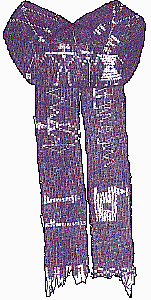 This wampum belt from the Vatican may be the oldest one preserved -- 1610 -- of Indian-white agreements. It represents a "Concordat between the Holy See and the Mik'maq Nation," of Nova Scotia, Canada. Grand sachem Henri Membertou was the first Catholic convert in Canada; they were caring for the buildings at Port Royal during the period 1608-1611 when the French abandoned them. He continued to act as a leader in a medicine society and to have several wives, as needed to maintain the hospitality and duties of a sachem's household. Pressured, he finally agreed to give up all but one. Upon his deathbed, he refused to go to the Christian heaven, because he wanted to be with the rest of his relatives. The right side of the belt represents agreement by the Clan Mothers. Even today there are special diplomatic relations between the Vatican and the modern Mik'maq Nations.
This wampum belt from the Vatican may be the oldest one preserved -- 1610 -- of Indian-white agreements. It represents a "Concordat between the Holy See and the Mik'maq Nation," of Nova Scotia, Canada. Grand sachem Henri Membertou was the first Catholic convert in Canada; they were caring for the buildings at Port Royal during the period 1608-1611 when the French abandoned them. He continued to act as a leader in a medicine society and to have several wives, as needed to maintain the hospitality and duties of a sachem's household. Pressured, he finally agreed to give up all but one. Upon his deathbed, he refused to go to the Christian heaven, because he wanted to be with the rest of his relatives. The right side of the belt represents agreement by the Clan Mothers. Even today there are special diplomatic relations between the Vatican and the modern Mik'maq Nations.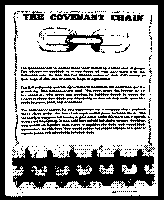 The covenant represented is actually older. At left is a poster made by Akwesasne Notes in 1988, from memorized teachings recited annually to the Longhouse people at Onondaga. The text says:
The covenant represented is actually older. At left is a poster made by Akwesasne Notes in 1988, from memorized teachings recited annually to the Longhouse people at Onondaga. The text says: